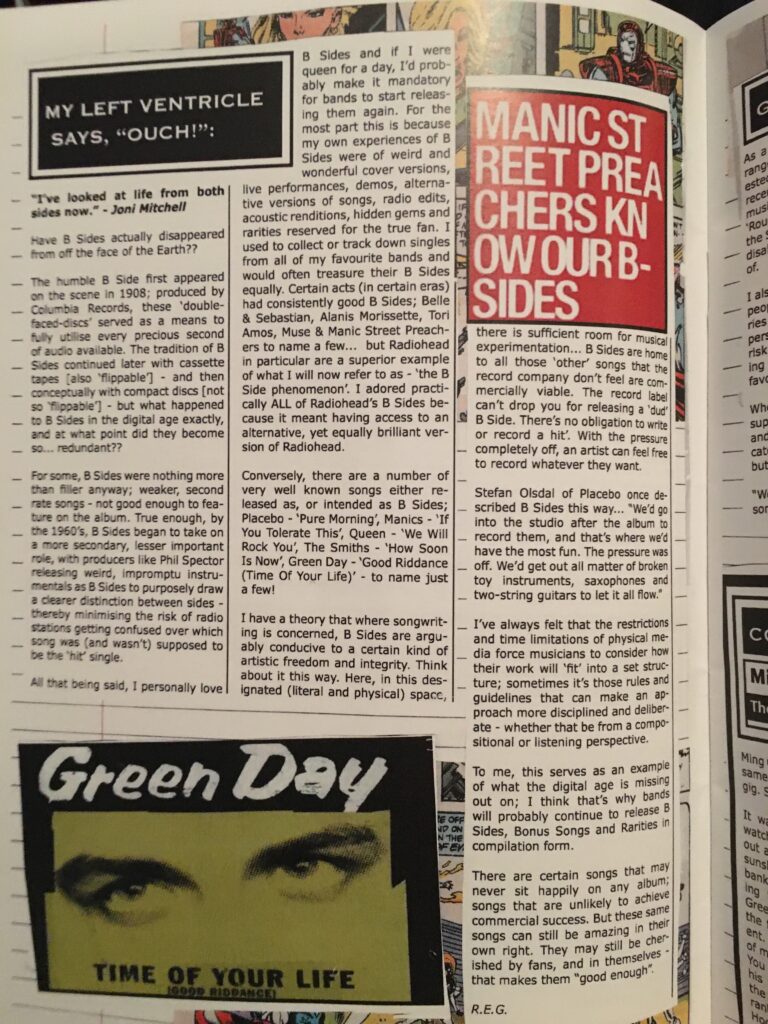“I’ve looked at life from both sides now.” – Joni Mitchell
Have B Sides actually disappeared from off the face of the Earth??
The humble B Side first appeared on the scene in 1908; produced by Columbia Records, these ‘double-faced-discs’ served as a means to fully utilise every precious second of audio available. The tradition of B Sides continued later with cassette tapes [also ‘flippable’] – and then conceptually with compact discs [not so ‘flippable’] – but what happened to B Sides in the digital age exactly, and at what point did they become so… redundant??
For some, B Sides were nothing more than filler anyway; weaker, second rate songs – not good enough to feature on the album. True enough, by the 1960’s, B Sides began to take on a more secondary, lesser important role, with producers like Phil Spector releasing weird, impromptu instrumentals as B Sides to purposely draw a clearer distinction between sides – thereby minimising the risk of radio stations getting confused over which song was (and wasn’t) supposed to be the “hit” single.

‘My Left Ventricle Says “Ouch!” – Point Blank Teesside Magazine – “Have B Sides actually disappeared from off the face of the Earth??
All that being said, I personally love B Sides and if I were queen for a day, I’d probably make it mandatory for bands to start releasing them again. For the most part this is because my own experiences of B Sides were of weird and wonderful cover versions, live performances, demos, alternative versions of songs, radio edits, acoustic renditions, hidden gems and rarities reserved for the true fan. I used to collect or track down singles from all of my favourite bands and would often treasure their B Sides equally. Certain acts (in certain eras) had consistently good B Sides; Belle & Sebastian, Alanis Morissette, Tori Amos, Muse & Manic Street Preachers to name a few… but Radiohead in particular are a superior example of what I will now refer to as – ‘the B Side phenomenon.’ I adored practically ALL of Radiohead’s B Sides because it meant having access to an alternative, yet equally brilliant version of Radiohead.
Conversely, there are a number of very well known songs either released as, or intended as B Sides; Placebo – Pure Morning; Manics – If You Tolerate This; Queen – We Will Rock You; The Smiths – How Soon Is Now; Green Day – Good Riddance (Time Of Your Life) – to name just a few!
I have a theory that where songwriting is concerned, B Sides are arguably conducive to a certain kind of artistic freedom and integrity.
Think about it this way. Here, in this designated (literal and physical) space, there is sufficient room for musical experimentation… B Sides are home to all those ‘other’ songs that the record company don’t feel are commercially viable. The record label can’t drop you for releasing a ‘dud’ B Side. There’s no obligation to write or record a “hit.” With the pressure completely off, an artist can feel free to record whatever they want.
Stefan Olsdal of Placebo once described B Sides this way… “We’d go into the studio after the album to record them, and that’s where we’d have the most fun. The pressure was off. We’d get out all matter of broken toy instruments, saxophones and two-string guitars to let it all flow.”
I’ve always felt that the restrictions and time limitations of physical media force musicians to consider how their work will ‘fit’ into a set structure; sometimes it’s those rules and guidelines that can make an approach more disciplined and deliberate – whether that be from a compositional or listening perspective. To me, this serves as an example of what the digital age is missing out on; I think that’s why bands will probably continue to release B Sides, Bonus Songs and Rarities in compilation form.
There are certain songs that may never sit happily on any album; songs that are unlikely to achieve commercial success. But these same songs can still be amazing in their own right. They may still be cherished by fans, and in themselves – that makes them ‘good enough.’
B Sides Article Point Blank Teesside
Written by Girl From Winter Jargon – North East England Musician, Dark Cabaret/Neo Classical/Proto Grunge Alternative Artist
This article was originally published in #16 Issue of Point Blank Teesside; Local Music Magazine, North East England under the column, “My Left Ventricle Says “Ouch!”;”
Spotify Playlist = Really good, totally decent B Sides from the 90s +
A celebration of by some of my favourite B Sides, including many featured in this article, via a helpful Spotify Playlist
More Music Articles Written by or featuring Girl From Winter Jargon:
My Top 5 Most Inspirational Guitarists
Is Ageism In Music Really A Thing?
Have B Sides actually disappeared from off the face of the Earth??
Wives and Lovers – Most Sexist Song Ever?
What is Dark Cabaret Music?
What is Permanent Wave Music?
What is Chamber Psych Music?